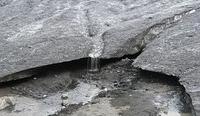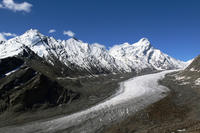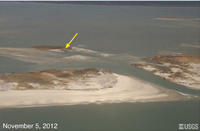-
Water resources management in a changing world
Visualize a dusty place where stream beds are sand and lakes are flats of dried mud; are we on Mars? In fact, we are on arid parts of Earth, a planet where water covers some 70 percent of the surface; how long will water be readily available to nourish life here? In the United States, more than thirty-six states face water shortages; other parts of the world are faring no better
-
-
World’s great rivers running on empty
Four of the world’s great rivers are all suffering from drastically reduced flows as a direct result of water extraction, according to new research; the researchers found that in all four river basins, over a long period of time, outflows have greatly reduced as a direct result of increased water extractions, and that urgent changes in governance of water are needed to ensure the systems remain healthy and viable
-
-
Humble microbes fighting harmful greenhouse gas
The environment has a more formidable opponent than carbon dioxide; another greenhouse gas, nitrous oxide, is 300 times more potent and also destroys the ozone layer each time it is released into the atmosphere through agricultural practices, sewage treatment, and fossil fuel combustion; luckily, nature has a larger army than previously thought combating this greenhouse gas
-
-
Warming to shift heavy rainfall patterns across U.K.
Researchers investigating the potential changes in extreme rainfall patterns across the United Kingdom as a result of global warming have found that in some regions of the country, the time of year when we see the heaviest rainfall is set to shift
-
-
Greenhouse gas concentrations in the atmosphere reach new record
The amount of greenhouse gases in the atmosphere reached a new record high in 2011, according to the World Meteorological Organization (WMO); between 1990 and 2011 there was a 30 percent increase in radiative forcing — the warming effect on our climate — because of carbon dioxide (CO2) and other heat-trapping long-lived gases; a new WMO Greenhouse Gas Bulletin highlights pivotal role of carbon sinks
-
-
Learning the lessons of the BP oil spill

In an attempt to limit the harm of the Deepwater Horizon oil spill in the Gulf of Mexico in 2010, three million liters of dispersant were used to dissipate the oil; on the surface the damage seems limited, but the seabed is covered with a thick layer of gunk; scientist from around the world are now working on models that can be consulted by decision makers when there is another oil spill disaster
-
-
The challenge of securing food and water supplies in the twenty-first century
Participants in the Food Security in Dry Lands (FSDL) conference, held last week in Qatar, agreed that the task of managing food and water resources more efficiently and improving the security of supply are set to become one of the biggest challenges for policy makers in the twenty-first century
-
-
Combining CO2 storage with enhanced oil recovery can aid U.K. economy
Combining carbon storage with enhanced oil recovery techniques in key fields could generate up to 2.7 billion pounds in extra economic output; if a combination of carbon storage and enhanced recovery techniques is fully exploited, it is estimated that nineteen potentially suitable oil fields on the U.K. Continental Shelf (UKCS) could contribute 15 percent of all UKCS oil production by 2030
-
-
“Soft infrastructure” as storm surge defense alternatives
The flooding in New York and New Jersey caused by Superstorm Sandy prompted calls from Governor Andrew Cuomo and other officials to consider building storm surge barriers to protect Lower Manhattan from future catastrophes. Such a strategy, however, could make things even worse for outlying areas that were hit hard by the hurricane, such as Staten Island, the New Jersey Shore, and Long Island’s South Shore, a City College of New York landscape architecture professor warns; landscapers and engineers say that environmentally friendly “soft infrastructure” would mitigate flood damage without sending harm elsewhere
-
-
The world’s 300 000 glaciers are melting, causing sea level to rise

Anthropogenic climate change leads to melting glaciers and rising sea level; between 1902 and 2009, melting glaciers contributed eleven centimeters to sea level rise; they were therefore the most important cause of sea level rise; the scientists numerically modeled the changes of each of the world’s 300 000 glaciers
-
-
How groundwater pumping affects streamflow
Groundwater provides drinking water for millions of Americans and is the primary source of water to irrigate cropland in many of the nations most productive agricultural settings; although the benefits of groundwater development are many, groundwater pumping can reduce the flow of water in connected streams and rivers — a process called streamflow depletion by wells; new USGS report describes processes and misconceptions concerning the effects of groundwater pumping on streamflow
-
-
Snowpack, essential freshwater source for billions, threatened
Snowpack, an essential source of drinking water and agricultural irrigation for billions of people, could shrink significantly within the next thirty years; the news is particularly troubling for snowpack-dependent California — the largest producer of agriculture products in the country and the sixth-largest agriculture exporter in the world; by filling reservoirs and watering crops when warmer, drier weather sets in, mountain snowpack has become vital to people and ecosystems in regions such as the Western United States, Alpine Europe, Central Asia, and downstream of the Himalayas and Tibetan Plateau — home to more than 50 percent of the world’s population
-
-
Himalayan glaciers to shrink even if temperatures hold steady, risking South Asia water supply

Come rain or shine, or even snow, some glaciers of the Himalayas will continue shrinking for many years to come; the most conservative findings of a new research on Bhutan, a region in the bull’s-eye of the monsoonal Himalayas, indicate that even if climate remained steady, almost 10 percent of Bhutan’s glaciers would vanish within the next few decades; what is more, the amount of melt water coming off these glaciers could drop by 30 percent
-
-
Hurricane Sandy caused dramatic changes to hundreds of miles of East Coast shoreline

The United States Geological Survey (USGS) has released a series of aerial photographs showing before-and-after images of Hurricane Sandy’s impacts on the Atlantic Coast; the photos, part of a USGS assessment of coastal change from as far south as the Outer Banks of North Carolina to as far north as Massachusetts, show that the storm caused dramatic changes to portions of shoreline extending hundreds of miles
-
-
New fluorescence technology pinpoints oil leaks at sea
Cambridge Consultants uses fertility monitor technology in oil leak early warning system; the company has built an oil spill detection technology platform which is capable of detecting the natural fluorescence of even tiny amounts of oil in or on water
-
- All
- Regional
- Water
- Biometrics
- Borders/Immig
- Business
- Cybersecurity
- Detection
- Disasters
- Government
- Infrastructure
- International
- Public health
- Public Safety
- Communication interoperabillity
- Emergency services
- Emergency medical services
- Fire
- First response
- IEDs
- Law Enforcement
- Law Enforcement Technology
- Military technology
- Nonlethal weapons
- Nuclear weapons
- Personal protection equipment
- Police
- Notification /alert systems
- Situational awareness
- Weapons systems
- Sci-Tech
- Sector Reports
- Surveillance
- Transportation
Advertising & Marketing: advertise@newswirepubs.com
Editorial: editor@newswirepubs.com
General: info@newswirepubs.com
2010-2011 © News Wire Publications, LLC News Wire Publications, LLC
220 Old Country Road | Suite 200 | Mineola | New York | 11501
Permissions and Policies
Editorial: editor@newswirepubs.com
General: info@newswirepubs.com
2010-2011 © News Wire Publications, LLC News Wire Publications, LLC
220 Old Country Road | Suite 200 | Mineola | New York | 11501
Permissions and Policies
